Analyzing Innovation in Sustainable Business Development Practices
VerifiedAdded on 2023/06/12
|10
|2974
|66
Essay
AI Summary
This essay examines the critical role of innovation in fostering sustainable business development. It defines business models and disruptive technologies, using Volvo Group as a case study for smart connected products. The essay discusses the opportunities and threats of disruptive innovation, highlighting advantages like automation and disadvantages like security risks. It further explores business models as systems of processes, capabilities, and resources, emphasizing the interrelation between business models, strategies, and innovation. The analysis covers how organizations strive to innovate to maintain competitiveness and adapt to market dynamics, particularly in the digital age. The conclusion emphasizes the importance of business models in guiding operations and delivering value, especially in the face of disruptive innovation and evolving customer needs. Desklib provides access to similar essays and study tools for students.
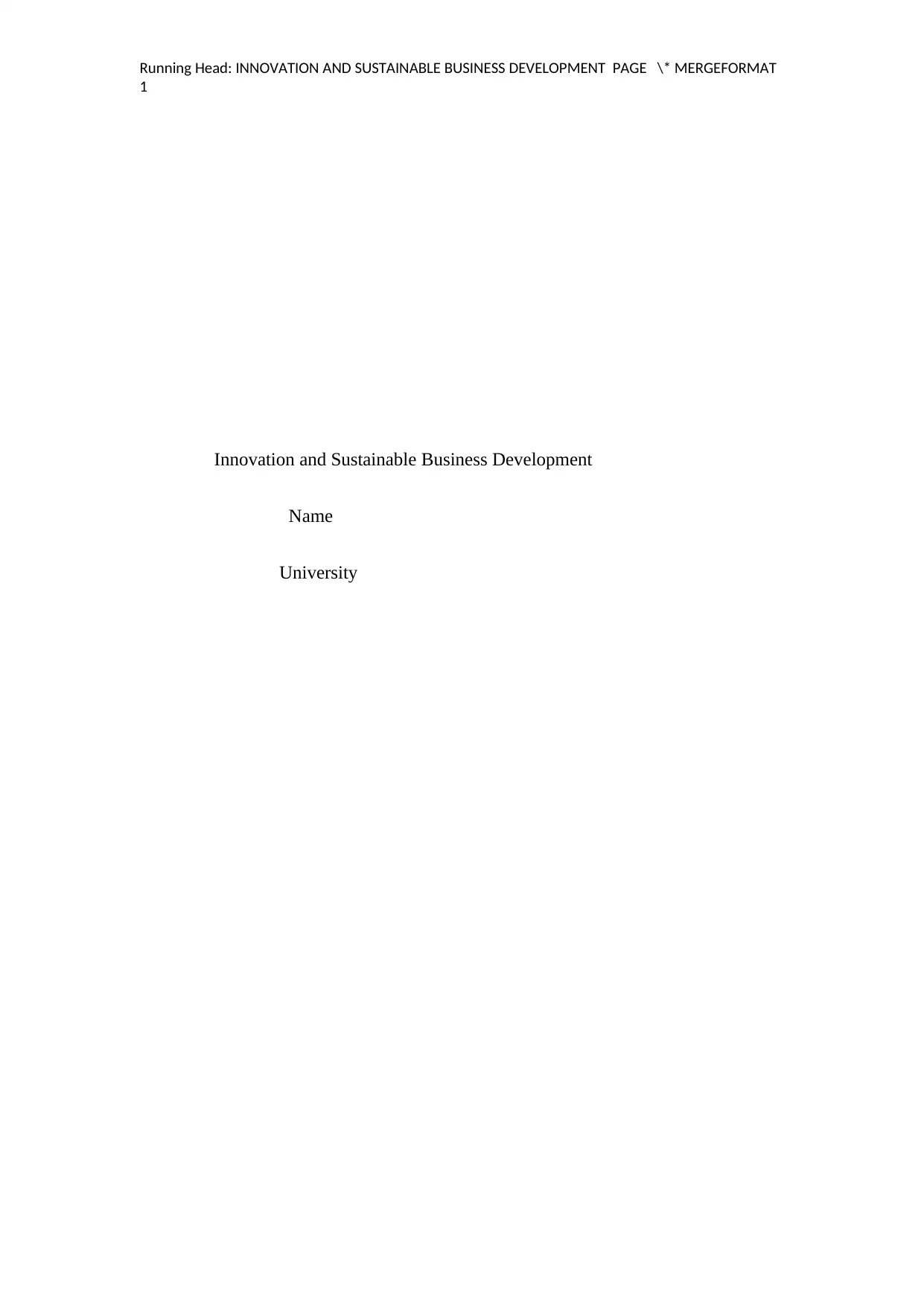
Running Head: INNOVATION AND SUSTAINABLE BUSINESS DEVELOPMENT PAGE \* MERGEFORMAT
1
Innovation and Sustainable Business Development
Name
University
1
Innovation and Sustainable Business Development
Name
University
Paraphrase This Document
Need a fresh take? Get an instant paraphrase of this document with our AI Paraphraser
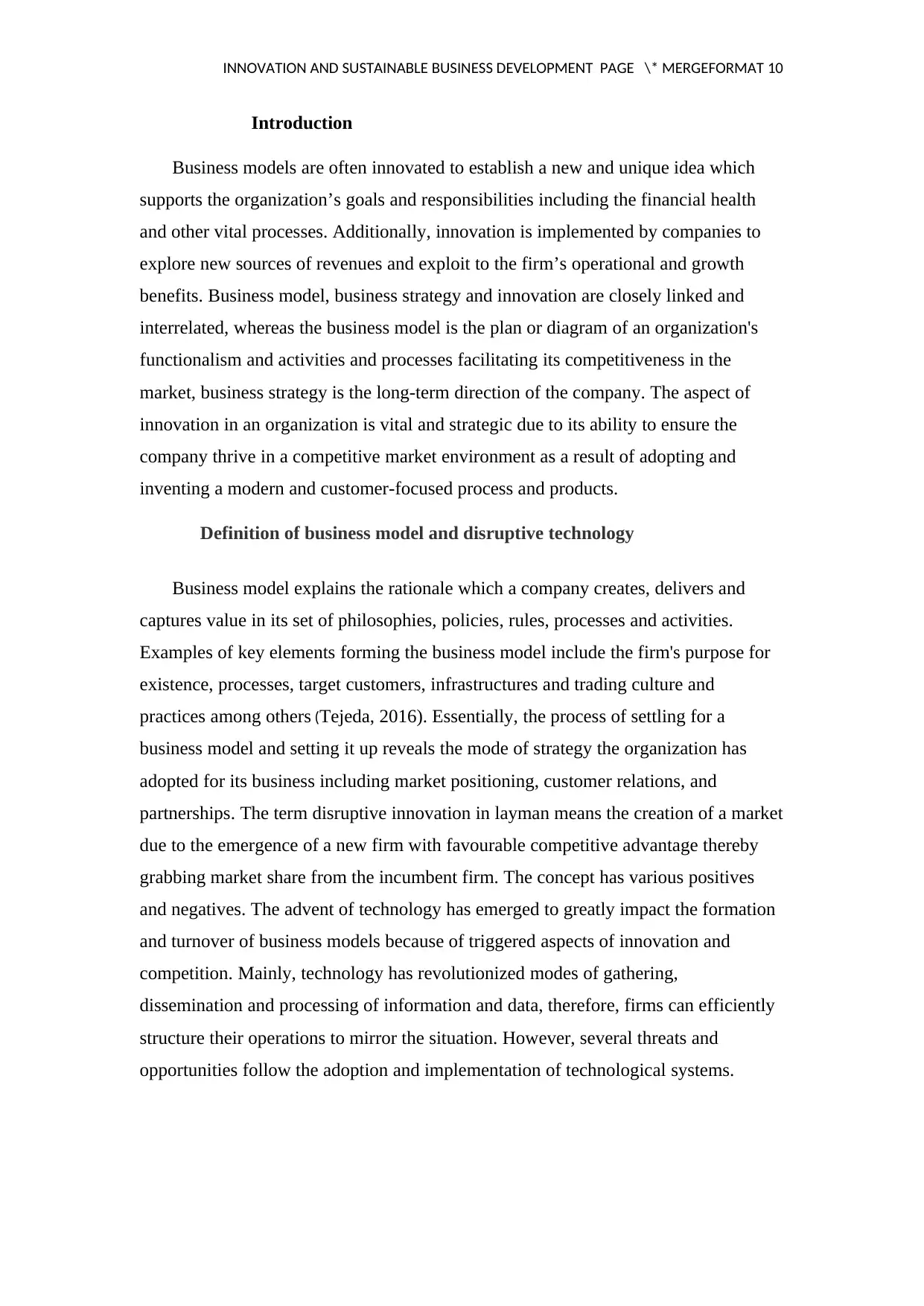
INNOVATION AND SUSTAINABLE BUSINESS DEVELOPMENT PAGE \* MERGEFORMAT 10
Introduction
Business models are often innovated to establish a new and unique idea which
supports the organization’s goals and responsibilities including the financial health
and other vital processes. Additionally, innovation is implemented by companies to
explore new sources of revenues and exploit to the firm’s operational and growth
benefits. Business model, business strategy and innovation are closely linked and
interrelated, whereas the business model is the plan or diagram of an organization's
functionalism and activities and processes facilitating its competitiveness in the
market, business strategy is the long-term direction of the company. The aspect of
innovation in an organization is vital and strategic due to its ability to ensure the
company thrive in a competitive market environment as a result of adopting and
inventing a modern and customer-focused process and products.
Definition of business model and disruptive technology
Business model explains the rationale which a company creates, delivers and
captures value in its set of philosophies, policies, rules, processes and activities.
Examples of key elements forming the business model include the firm's purpose for
existence, processes, target customers, infrastructures and trading culture and
practices among others (Tejeda, 2016). Essentially, the process of settling for a
business model and setting it up reveals the mode of strategy the organization has
adopted for its business including market positioning, customer relations, and
partnerships. The term disruptive innovation in layman means the creation of a market
due to the emergence of a new firm with favourable competitive advantage thereby
grabbing market share from the incumbent firm. The concept has various positives
and negatives. The advent of technology has emerged to greatly impact the formation
and turnover of business models because of triggered aspects of innovation and
competition. Mainly, technology has revolutionized modes of gathering,
dissemination and processing of information and data, therefore, firms can efficiently
structure their operations to mirror the situation. However, several threats and
opportunities follow the adoption and implementation of technological systems.
Introduction
Business models are often innovated to establish a new and unique idea which
supports the organization’s goals and responsibilities including the financial health
and other vital processes. Additionally, innovation is implemented by companies to
explore new sources of revenues and exploit to the firm’s operational and growth
benefits. Business model, business strategy and innovation are closely linked and
interrelated, whereas the business model is the plan or diagram of an organization's
functionalism and activities and processes facilitating its competitiveness in the
market, business strategy is the long-term direction of the company. The aspect of
innovation in an organization is vital and strategic due to its ability to ensure the
company thrive in a competitive market environment as a result of adopting and
inventing a modern and customer-focused process and products.
Definition of business model and disruptive technology
Business model explains the rationale which a company creates, delivers and
captures value in its set of philosophies, policies, rules, processes and activities.
Examples of key elements forming the business model include the firm's purpose for
existence, processes, target customers, infrastructures and trading culture and
practices among others (Tejeda, 2016). Essentially, the process of settling for a
business model and setting it up reveals the mode of strategy the organization has
adopted for its business including market positioning, customer relations, and
partnerships. The term disruptive innovation in layman means the creation of a market
due to the emergence of a new firm with favourable competitive advantage thereby
grabbing market share from the incumbent firm. The concept has various positives
and negatives. The advent of technology has emerged to greatly impact the formation
and turnover of business models because of triggered aspects of innovation and
competition. Mainly, technology has revolutionized modes of gathering,
dissemination and processing of information and data, therefore, firms can efficiently
structure their operations to mirror the situation. However, several threats and
opportunities follow the adoption and implementation of technological systems.
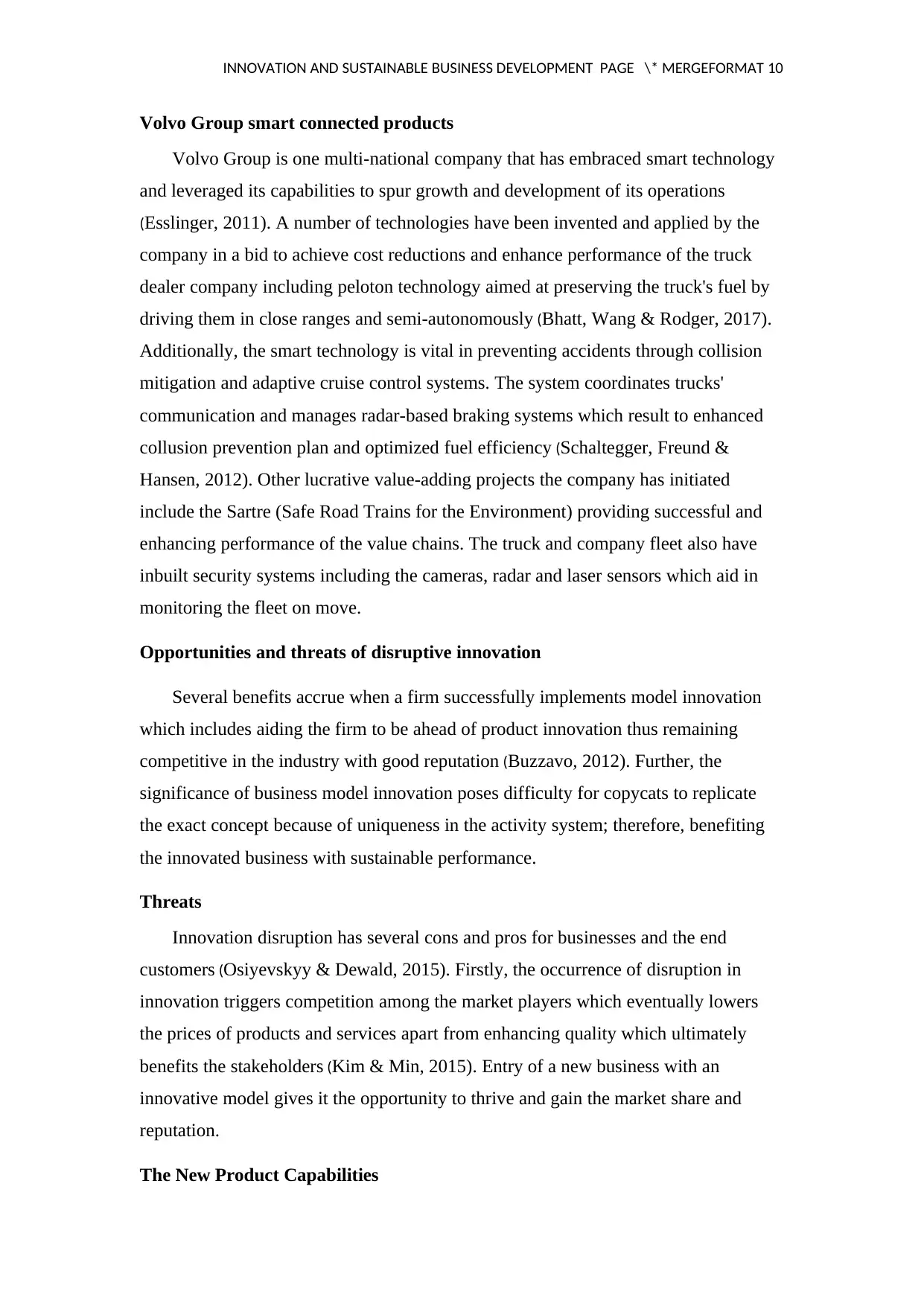
INNOVATION AND SUSTAINABLE BUSINESS DEVELOPMENT PAGE \* MERGEFORMAT 10
Volvo Group smart connected products
Volvo Group is one multi-national company that has embraced smart technology
and leveraged its capabilities to spur growth and development of its operations
(Esslinger, 2011). A number of technologies have been invented and applied by the
company in a bid to achieve cost reductions and enhance performance of the truck
dealer company including peloton technology aimed at preserving the truck's fuel by
driving them in close ranges and semi-autonomously (Bhatt, Wang & Rodger, 2017).
Additionally, the smart technology is vital in preventing accidents through collision
mitigation and adaptive cruise control systems. The system coordinates trucks'
communication and manages radar-based braking systems which result to enhanced
collusion prevention plan and optimized fuel efficiency (Schaltegger, Freund &
Hansen, 2012). Other lucrative value-adding projects the company has initiated
include the Sartre (Safe Road Trains for the Environment) providing successful and
enhancing performance of the value chains. The truck and company fleet also have
inbuilt security systems including the cameras, radar and laser sensors which aid in
monitoring the fleet on move.
Opportunities and threats of disruptive innovation
Several benefits accrue when a firm successfully implements model innovation
which includes aiding the firm to be ahead of product innovation thus remaining
competitive in the industry with good reputation (Buzzavo, 2012). Further, the
significance of business model innovation poses difficulty for copycats to replicate
the exact concept because of uniqueness in the activity system; therefore, benefiting
the innovated business with sustainable performance.
Threats
Innovation disruption has several cons and pros for businesses and the end
customers (Osiyevskyy & Dewald, 2015). Firstly, the occurrence of disruption in
innovation triggers competition among the market players which eventually lowers
the prices of products and services apart from enhancing quality which ultimately
benefits the stakeholders (Kim & Min, 2015). Entry of a new business with an
innovative model gives it the opportunity to thrive and gain the market share and
reputation.
The New Product Capabilities
Volvo Group smart connected products
Volvo Group is one multi-national company that has embraced smart technology
and leveraged its capabilities to spur growth and development of its operations
(Esslinger, 2011). A number of technologies have been invented and applied by the
company in a bid to achieve cost reductions and enhance performance of the truck
dealer company including peloton technology aimed at preserving the truck's fuel by
driving them in close ranges and semi-autonomously (Bhatt, Wang & Rodger, 2017).
Additionally, the smart technology is vital in preventing accidents through collision
mitigation and adaptive cruise control systems. The system coordinates trucks'
communication and manages radar-based braking systems which result to enhanced
collusion prevention plan and optimized fuel efficiency (Schaltegger, Freund &
Hansen, 2012). Other lucrative value-adding projects the company has initiated
include the Sartre (Safe Road Trains for the Environment) providing successful and
enhancing performance of the value chains. The truck and company fleet also have
inbuilt security systems including the cameras, radar and laser sensors which aid in
monitoring the fleet on move.
Opportunities and threats of disruptive innovation
Several benefits accrue when a firm successfully implements model innovation
which includes aiding the firm to be ahead of product innovation thus remaining
competitive in the industry with good reputation (Buzzavo, 2012). Further, the
significance of business model innovation poses difficulty for copycats to replicate
the exact concept because of uniqueness in the activity system; therefore, benefiting
the innovated business with sustainable performance.
Threats
Innovation disruption has several cons and pros for businesses and the end
customers (Osiyevskyy & Dewald, 2015). Firstly, the occurrence of disruption in
innovation triggers competition among the market players which eventually lowers
the prices of products and services apart from enhancing quality which ultimately
benefits the stakeholders (Kim & Min, 2015). Entry of a new business with an
innovative model gives it the opportunity to thrive and gain the market share and
reputation.
The New Product Capabilities
⊘ This is a preview!⊘
Do you want full access?
Subscribe today to unlock all pages.

Trusted by 1+ million students worldwide
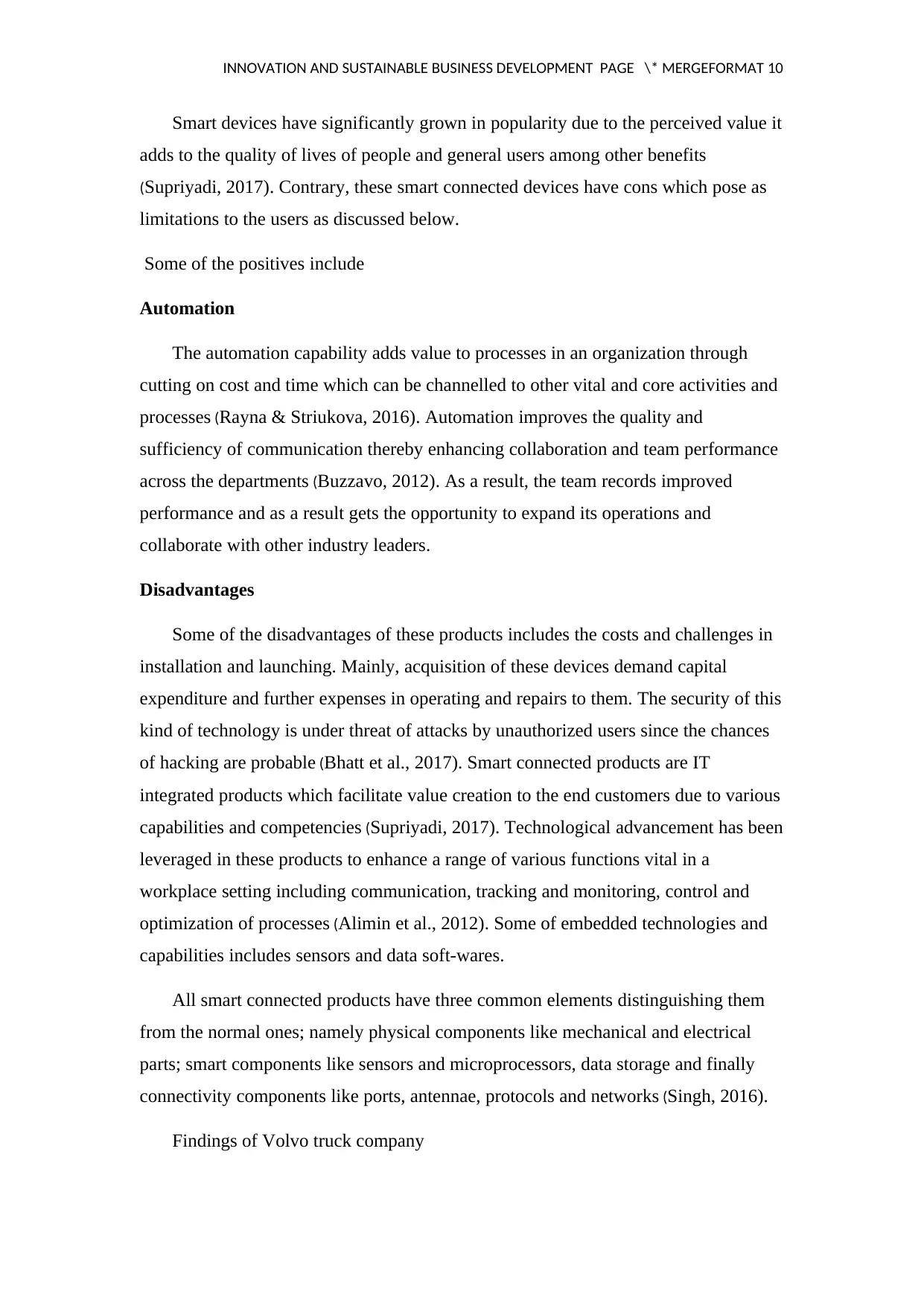
INNOVATION AND SUSTAINABLE BUSINESS DEVELOPMENT PAGE \* MERGEFORMAT 10
Smart devices have significantly grown in popularity due to the perceived value it
adds to the quality of lives of people and general users among other benefits
(Supriyadi, 2017). Contrary, these smart connected devices have cons which pose as
limitations to the users as discussed below.
Some of the positives include
Automation
The automation capability adds value to processes in an organization through
cutting on cost and time which can be channelled to other vital and core activities and
processes (Rayna & Striukova, 2016). Automation improves the quality and
sufficiency of communication thereby enhancing collaboration and team performance
across the departments (Buzzavo, 2012). As a result, the team records improved
performance and as a result gets the opportunity to expand its operations and
collaborate with other industry leaders.
Disadvantages
Some of the disadvantages of these products includes the costs and challenges in
installation and launching. Mainly, acquisition of these devices demand capital
expenditure and further expenses in operating and repairs to them. The security of this
kind of technology is under threat of attacks by unauthorized users since the chances
of hacking are probable (Bhatt et al., 2017). Smart connected products are IT
integrated products which facilitate value creation to the end customers due to various
capabilities and competencies (Supriyadi, 2017). Technological advancement has been
leveraged in these products to enhance a range of various functions vital in a
workplace setting including communication, tracking and monitoring, control and
optimization of processes (Alimin et al., 2012). Some of embedded technologies and
capabilities includes sensors and data soft-wares.
All smart connected products have three common elements distinguishing them
from the normal ones; namely physical components like mechanical and electrical
parts; smart components like sensors and microprocessors, data storage and finally
connectivity components like ports, antennae, protocols and networks (Singh, 2016).
Findings of Volvo truck company
Smart devices have significantly grown in popularity due to the perceived value it
adds to the quality of lives of people and general users among other benefits
(Supriyadi, 2017). Contrary, these smart connected devices have cons which pose as
limitations to the users as discussed below.
Some of the positives include
Automation
The automation capability adds value to processes in an organization through
cutting on cost and time which can be channelled to other vital and core activities and
processes (Rayna & Striukova, 2016). Automation improves the quality and
sufficiency of communication thereby enhancing collaboration and team performance
across the departments (Buzzavo, 2012). As a result, the team records improved
performance and as a result gets the opportunity to expand its operations and
collaborate with other industry leaders.
Disadvantages
Some of the disadvantages of these products includes the costs and challenges in
installation and launching. Mainly, acquisition of these devices demand capital
expenditure and further expenses in operating and repairs to them. The security of this
kind of technology is under threat of attacks by unauthorized users since the chances
of hacking are probable (Bhatt et al., 2017). Smart connected products are IT
integrated products which facilitate value creation to the end customers due to various
capabilities and competencies (Supriyadi, 2017). Technological advancement has been
leveraged in these products to enhance a range of various functions vital in a
workplace setting including communication, tracking and monitoring, control and
optimization of processes (Alimin et al., 2012). Some of embedded technologies and
capabilities includes sensors and data soft-wares.
All smart connected products have three common elements distinguishing them
from the normal ones; namely physical components like mechanical and electrical
parts; smart components like sensors and microprocessors, data storage and finally
connectivity components like ports, antennae, protocols and networks (Singh, 2016).
Findings of Volvo truck company
Paraphrase This Document
Need a fresh take? Get an instant paraphrase of this document with our AI Paraphraser
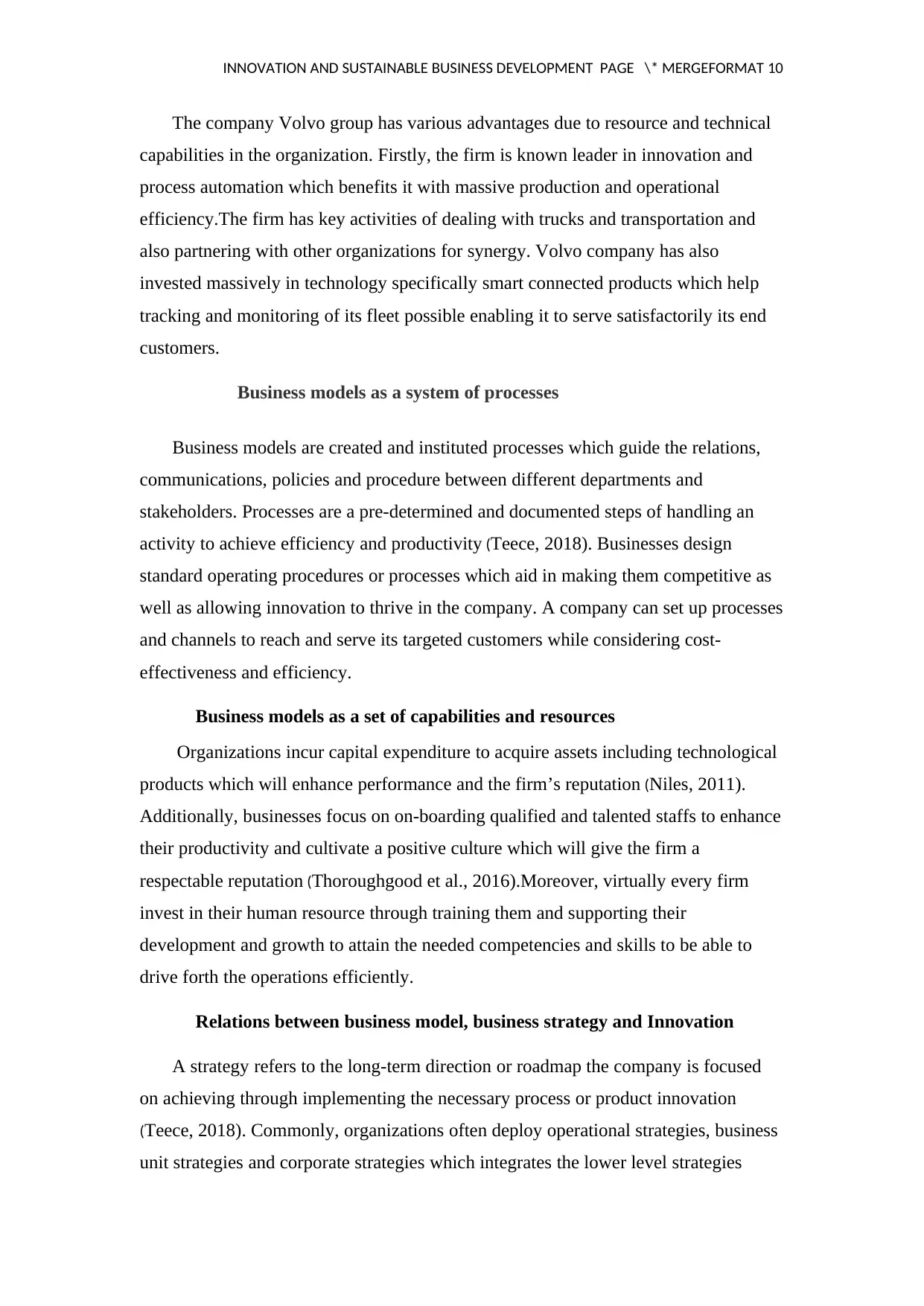
INNOVATION AND SUSTAINABLE BUSINESS DEVELOPMENT PAGE \* MERGEFORMAT 10
The company Volvo group has various advantages due to resource and technical
capabilities in the organization. Firstly, the firm is known leader in innovation and
process automation which benefits it with massive production and operational
efficiency.The firm has key activities of dealing with trucks and transportation and
also partnering with other organizations for synergy. Volvo company has also
invested massively in technology specifically smart connected products which help
tracking and monitoring of its fleet possible enabling it to serve satisfactorily its end
customers.
Business models as a system of processes
Business models are created and instituted processes which guide the relations,
communications, policies and procedure between different departments and
stakeholders. Processes are a pre-determined and documented steps of handling an
activity to achieve efficiency and productivity (Teece, 2018). Businesses design
standard operating procedures or processes which aid in making them competitive as
well as allowing innovation to thrive in the company. A company can set up processes
and channels to reach and serve its targeted customers while considering cost-
effectiveness and efficiency.
Business models as a set of capabilities and resources
Organizations incur capital expenditure to acquire assets including technological
products which will enhance performance and the firm’s reputation (Niles, 2011).
Additionally, businesses focus on on-boarding qualified and talented staffs to enhance
their productivity and cultivate a positive culture which will give the firm a
respectable reputation (Thoroughgood et al., 2016).Moreover, virtually every firm
invest in their human resource through training them and supporting their
development and growth to attain the needed competencies and skills to be able to
drive forth the operations efficiently.
Relations between business model, business strategy and Innovation
A strategy refers to the long-term direction or roadmap the company is focused
on achieving through implementing the necessary process or product innovation
(Teece, 2018). Commonly, organizations often deploy operational strategies, business
unit strategies and corporate strategies which integrates the lower level strategies
The company Volvo group has various advantages due to resource and technical
capabilities in the organization. Firstly, the firm is known leader in innovation and
process automation which benefits it with massive production and operational
efficiency.The firm has key activities of dealing with trucks and transportation and
also partnering with other organizations for synergy. Volvo company has also
invested massively in technology specifically smart connected products which help
tracking and monitoring of its fleet possible enabling it to serve satisfactorily its end
customers.
Business models as a system of processes
Business models are created and instituted processes which guide the relations,
communications, policies and procedure between different departments and
stakeholders. Processes are a pre-determined and documented steps of handling an
activity to achieve efficiency and productivity (Teece, 2018). Businesses design
standard operating procedures or processes which aid in making them competitive as
well as allowing innovation to thrive in the company. A company can set up processes
and channels to reach and serve its targeted customers while considering cost-
effectiveness and efficiency.
Business models as a set of capabilities and resources
Organizations incur capital expenditure to acquire assets including technological
products which will enhance performance and the firm’s reputation (Niles, 2011).
Additionally, businesses focus on on-boarding qualified and talented staffs to enhance
their productivity and cultivate a positive culture which will give the firm a
respectable reputation (Thoroughgood et al., 2016).Moreover, virtually every firm
invest in their human resource through training them and supporting their
development and growth to attain the needed competencies and skills to be able to
drive forth the operations efficiently.
Relations between business model, business strategy and Innovation
A strategy refers to the long-term direction or roadmap the company is focused
on achieving through implementing the necessary process or product innovation
(Teece, 2018). Commonly, organizations often deploy operational strategies, business
unit strategies and corporate strategies which integrates the lower level strategies
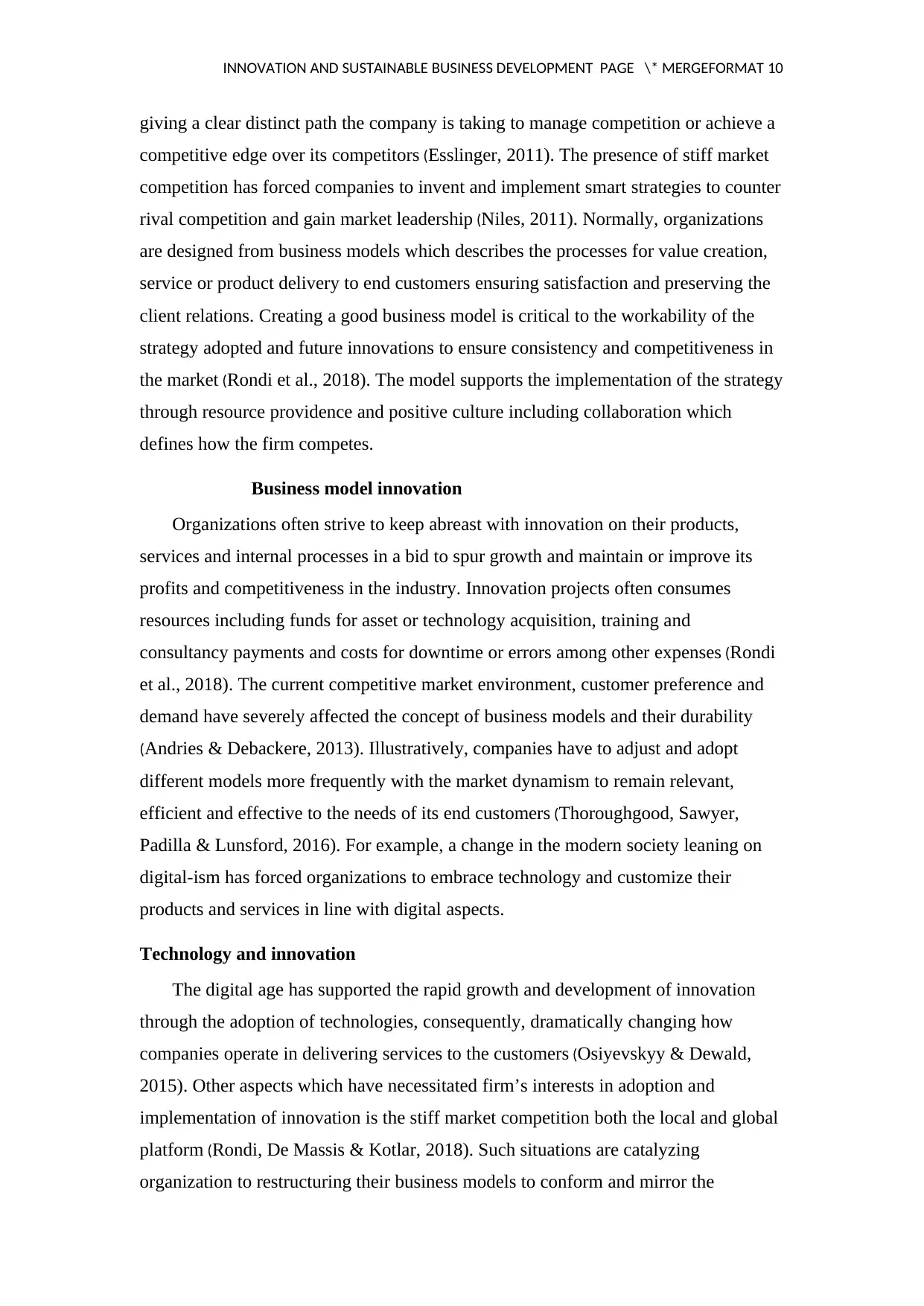
INNOVATION AND SUSTAINABLE BUSINESS DEVELOPMENT PAGE \* MERGEFORMAT 10
giving a clear distinct path the company is taking to manage competition or achieve a
competitive edge over its competitors (Esslinger, 2011). The presence of stiff market
competition has forced companies to invent and implement smart strategies to counter
rival competition and gain market leadership (Niles, 2011). Normally, organizations
are designed from business models which describes the processes for value creation,
service or product delivery to end customers ensuring satisfaction and preserving the
client relations. Creating a good business model is critical to the workability of the
strategy adopted and future innovations to ensure consistency and competitiveness in
the market (Rondi et al., 2018). The model supports the implementation of the strategy
through resource providence and positive culture including collaboration which
defines how the firm competes.
Business model innovation
Organizations often strive to keep abreast with innovation on their products,
services and internal processes in a bid to spur growth and maintain or improve its
profits and competitiveness in the industry. Innovation projects often consumes
resources including funds for asset or technology acquisition, training and
consultancy payments and costs for downtime or errors among other expenses (Rondi
et al., 2018). The current competitive market environment, customer preference and
demand have severely affected the concept of business models and their durability
(Andries & Debackere, 2013). Illustratively, companies have to adjust and adopt
different models more frequently with the market dynamism to remain relevant,
efficient and effective to the needs of its end customers (Thoroughgood, Sawyer,
Padilla & Lunsford, 2016). For example, a change in the modern society leaning on
digital-ism has forced organizations to embrace technology and customize their
products and services in line with digital aspects.
Technology and innovation
The digital age has supported the rapid growth and development of innovation
through the adoption of technologies, consequently, dramatically changing how
companies operate in delivering services to the customers (Osiyevskyy & Dewald,
2015). Other aspects which have necessitated firm’s interests in adoption and
implementation of innovation is the stiff market competition both the local and global
platform (Rondi, De Massis & Kotlar, 2018). Such situations are catalyzing
organization to restructuring their business models to conform and mirror the
giving a clear distinct path the company is taking to manage competition or achieve a
competitive edge over its competitors (Esslinger, 2011). The presence of stiff market
competition has forced companies to invent and implement smart strategies to counter
rival competition and gain market leadership (Niles, 2011). Normally, organizations
are designed from business models which describes the processes for value creation,
service or product delivery to end customers ensuring satisfaction and preserving the
client relations. Creating a good business model is critical to the workability of the
strategy adopted and future innovations to ensure consistency and competitiveness in
the market (Rondi et al., 2018). The model supports the implementation of the strategy
through resource providence and positive culture including collaboration which
defines how the firm competes.
Business model innovation
Organizations often strive to keep abreast with innovation on their products,
services and internal processes in a bid to spur growth and maintain or improve its
profits and competitiveness in the industry. Innovation projects often consumes
resources including funds for asset or technology acquisition, training and
consultancy payments and costs for downtime or errors among other expenses (Rondi
et al., 2018). The current competitive market environment, customer preference and
demand have severely affected the concept of business models and their durability
(Andries & Debackere, 2013). Illustratively, companies have to adjust and adopt
different models more frequently with the market dynamism to remain relevant,
efficient and effective to the needs of its end customers (Thoroughgood, Sawyer,
Padilla & Lunsford, 2016). For example, a change in the modern society leaning on
digital-ism has forced organizations to embrace technology and customize their
products and services in line with digital aspects.
Technology and innovation
The digital age has supported the rapid growth and development of innovation
through the adoption of technologies, consequently, dramatically changing how
companies operate in delivering services to the customers (Osiyevskyy & Dewald,
2015). Other aspects which have necessitated firm’s interests in adoption and
implementation of innovation is the stiff market competition both the local and global
platform (Rondi, De Massis & Kotlar, 2018). Such situations are catalyzing
organization to restructuring their business models to conform and mirror the
⊘ This is a preview!⊘
Do you want full access?
Subscribe today to unlock all pages.

Trusted by 1+ million students worldwide
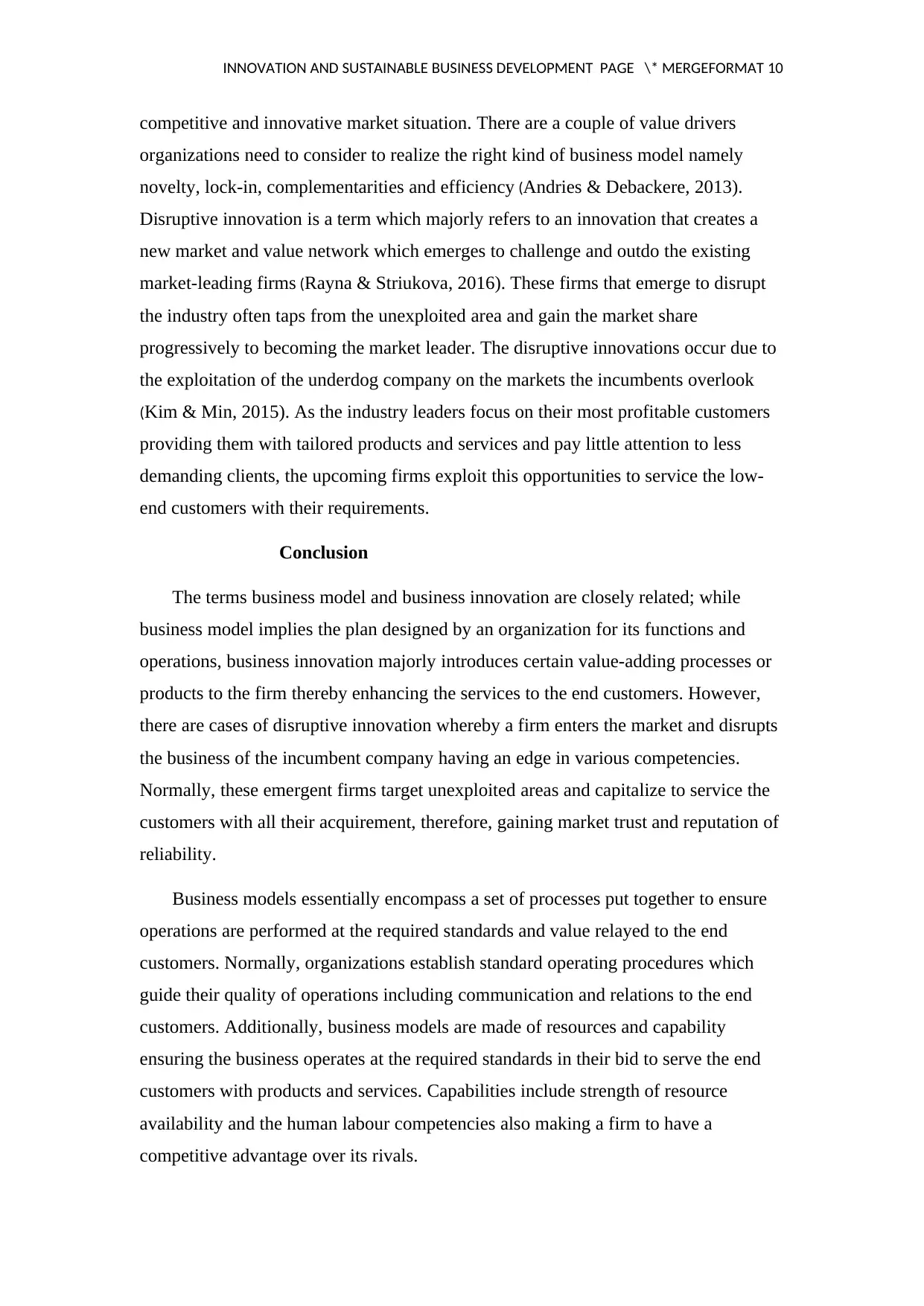
INNOVATION AND SUSTAINABLE BUSINESS DEVELOPMENT PAGE \* MERGEFORMAT 10
competitive and innovative market situation. There are a couple of value drivers
organizations need to consider to realize the right kind of business model namely
novelty, lock-in, complementarities and efficiency (Andries & Debackere, 2013).
Disruptive innovation is a term which majorly refers to an innovation that creates a
new market and value network which emerges to challenge and outdo the existing
market-leading firms (Rayna & Striukova, 2016). These firms that emerge to disrupt
the industry often taps from the unexploited area and gain the market share
progressively to becoming the market leader. The disruptive innovations occur due to
the exploitation of the underdog company on the markets the incumbents overlook
(Kim & Min, 2015). As the industry leaders focus on their most profitable customers
providing them with tailored products and services and pay little attention to less
demanding clients, the upcoming firms exploit this opportunities to service the low-
end customers with their requirements.
Conclusion
The terms business model and business innovation are closely related; while
business model implies the plan designed by an organization for its functions and
operations, business innovation majorly introduces certain value-adding processes or
products to the firm thereby enhancing the services to the end customers. However,
there are cases of disruptive innovation whereby a firm enters the market and disrupts
the business of the incumbent company having an edge in various competencies.
Normally, these emergent firms target unexploited areas and capitalize to service the
customers with all their acquirement, therefore, gaining market trust and reputation of
reliability.
Business models essentially encompass a set of processes put together to ensure
operations are performed at the required standards and value relayed to the end
customers. Normally, organizations establish standard operating procedures which
guide their quality of operations including communication and relations to the end
customers. Additionally, business models are made of resources and capability
ensuring the business operates at the required standards in their bid to serve the end
customers with products and services. Capabilities include strength of resource
availability and the human labour competencies also making a firm to have a
competitive advantage over its rivals.
competitive and innovative market situation. There are a couple of value drivers
organizations need to consider to realize the right kind of business model namely
novelty, lock-in, complementarities and efficiency (Andries & Debackere, 2013).
Disruptive innovation is a term which majorly refers to an innovation that creates a
new market and value network which emerges to challenge and outdo the existing
market-leading firms (Rayna & Striukova, 2016). These firms that emerge to disrupt
the industry often taps from the unexploited area and gain the market share
progressively to becoming the market leader. The disruptive innovations occur due to
the exploitation of the underdog company on the markets the incumbents overlook
(Kim & Min, 2015). As the industry leaders focus on their most profitable customers
providing them with tailored products and services and pay little attention to less
demanding clients, the upcoming firms exploit this opportunities to service the low-
end customers with their requirements.
Conclusion
The terms business model and business innovation are closely related; while
business model implies the plan designed by an organization for its functions and
operations, business innovation majorly introduces certain value-adding processes or
products to the firm thereby enhancing the services to the end customers. However,
there are cases of disruptive innovation whereby a firm enters the market and disrupts
the business of the incumbent company having an edge in various competencies.
Normally, these emergent firms target unexploited areas and capitalize to service the
customers with all their acquirement, therefore, gaining market trust and reputation of
reliability.
Business models essentially encompass a set of processes put together to ensure
operations are performed at the required standards and value relayed to the end
customers. Normally, organizations establish standard operating procedures which
guide their quality of operations including communication and relations to the end
customers. Additionally, business models are made of resources and capability
ensuring the business operates at the required standards in their bid to serve the end
customers with products and services. Capabilities include strength of resource
availability and the human labour competencies also making a firm to have a
competitive advantage over its rivals.
Paraphrase This Document
Need a fresh take? Get an instant paraphrase of this document with our AI Paraphraser
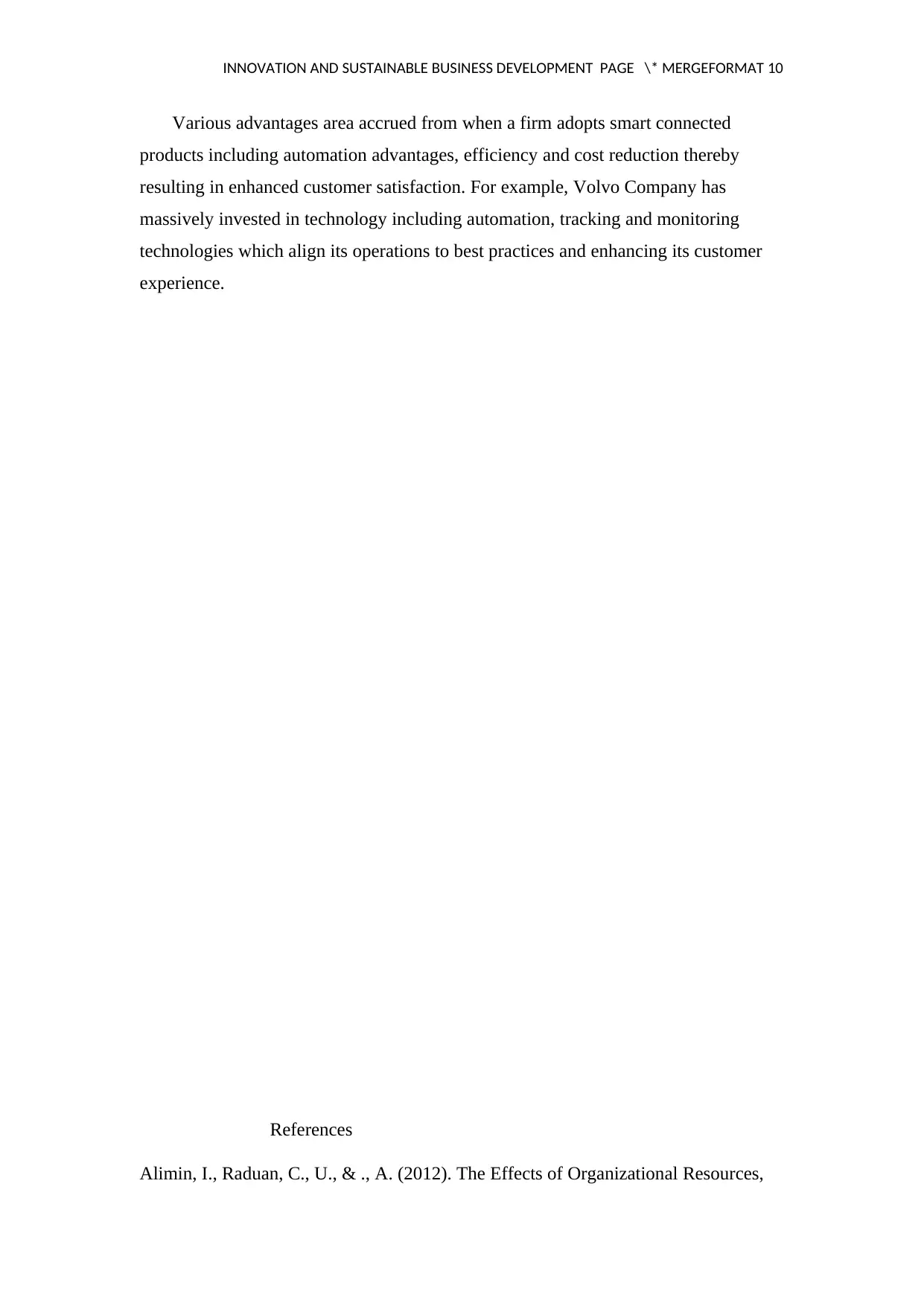
INNOVATION AND SUSTAINABLE BUSINESS DEVELOPMENT PAGE \* MERGEFORMAT 10
Various advantages area accrued from when a firm adopts smart connected
products including automation advantages, efficiency and cost reduction thereby
resulting in enhanced customer satisfaction. For example, Volvo Company has
massively invested in technology including automation, tracking and monitoring
technologies which align its operations to best practices and enhancing its customer
experience.
References
Alimin, I., Raduan, C., U., & ., A. (2012). The Effects of Organizational Resources,
Various advantages area accrued from when a firm adopts smart connected
products including automation advantages, efficiency and cost reduction thereby
resulting in enhanced customer satisfaction. For example, Volvo Company has
massively invested in technology including automation, tracking and monitoring
technologies which align its operations to best practices and enhancing its customer
experience.
References
Alimin, I., Raduan, C., U., & ., A. (2012). The Effects of Organizational Resources,
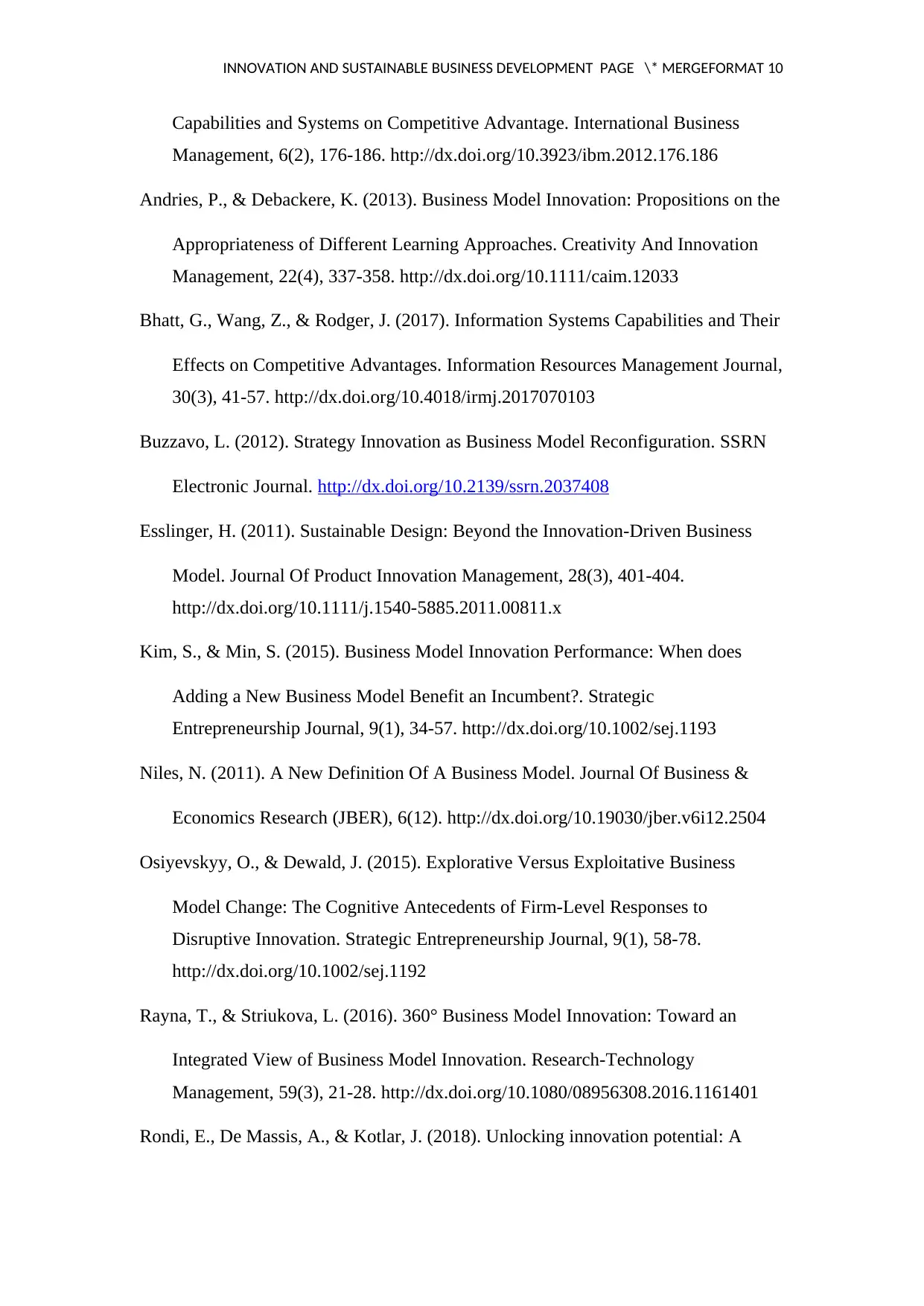
INNOVATION AND SUSTAINABLE BUSINESS DEVELOPMENT PAGE \* MERGEFORMAT 10
Capabilities and Systems on Competitive Advantage. International Business
Management, 6(2), 176-186. http://dx.doi.org/10.3923/ibm.2012.176.186
Andries, P., & Debackere, K. (2013). Business Model Innovation: Propositions on the
Appropriateness of Different Learning Approaches. Creativity And Innovation
Management, 22(4), 337-358. http://dx.doi.org/10.1111/caim.12033
Bhatt, G., Wang, Z., & Rodger, J. (2017). Information Systems Capabilities and Their
Effects on Competitive Advantages. Information Resources Management Journal,
30(3), 41-57. http://dx.doi.org/10.4018/irmj.2017070103
Buzzavo, L. (2012). Strategy Innovation as Business Model Reconfiguration. SSRN
Electronic Journal. http://dx.doi.org/10.2139/ssrn.2037408
Esslinger, H. (2011). Sustainable Design: Beyond the Innovation-Driven Business
Model. Journal Of Product Innovation Management, 28(3), 401-404.
http://dx.doi.org/10.1111/j.1540-5885.2011.00811.x
Kim, S., & Min, S. (2015). Business Model Innovation Performance: When does
Adding a New Business Model Benefit an Incumbent?. Strategic
Entrepreneurship Journal, 9(1), 34-57. http://dx.doi.org/10.1002/sej.1193
Niles, N. (2011). A New Definition Of A Business Model. Journal Of Business &
Economics Research (JBER), 6(12). http://dx.doi.org/10.19030/jber.v6i12.2504
Osiyevskyy, O., & Dewald, J. (2015). Explorative Versus Exploitative Business
Model Change: The Cognitive Antecedents of Firm-Level Responses to
Disruptive Innovation. Strategic Entrepreneurship Journal, 9(1), 58-78.
http://dx.doi.org/10.1002/sej.1192
Rayna, T., & Striukova, L. (2016). 360° Business Model Innovation: Toward an
Integrated View of Business Model Innovation. Research-Technology
Management, 59(3), 21-28. http://dx.doi.org/10.1080/08956308.2016.1161401
Rondi, E., De Massis, A., & Kotlar, J. (2018). Unlocking innovation potential: A
Capabilities and Systems on Competitive Advantage. International Business
Management, 6(2), 176-186. http://dx.doi.org/10.3923/ibm.2012.176.186
Andries, P., & Debackere, K. (2013). Business Model Innovation: Propositions on the
Appropriateness of Different Learning Approaches. Creativity And Innovation
Management, 22(4), 337-358. http://dx.doi.org/10.1111/caim.12033
Bhatt, G., Wang, Z., & Rodger, J. (2017). Information Systems Capabilities and Their
Effects on Competitive Advantages. Information Resources Management Journal,
30(3), 41-57. http://dx.doi.org/10.4018/irmj.2017070103
Buzzavo, L. (2012). Strategy Innovation as Business Model Reconfiguration. SSRN
Electronic Journal. http://dx.doi.org/10.2139/ssrn.2037408
Esslinger, H. (2011). Sustainable Design: Beyond the Innovation-Driven Business
Model. Journal Of Product Innovation Management, 28(3), 401-404.
http://dx.doi.org/10.1111/j.1540-5885.2011.00811.x
Kim, S., & Min, S. (2015). Business Model Innovation Performance: When does
Adding a New Business Model Benefit an Incumbent?. Strategic
Entrepreneurship Journal, 9(1), 34-57. http://dx.doi.org/10.1002/sej.1193
Niles, N. (2011). A New Definition Of A Business Model. Journal Of Business &
Economics Research (JBER), 6(12). http://dx.doi.org/10.19030/jber.v6i12.2504
Osiyevskyy, O., & Dewald, J. (2015). Explorative Versus Exploitative Business
Model Change: The Cognitive Antecedents of Firm-Level Responses to
Disruptive Innovation. Strategic Entrepreneurship Journal, 9(1), 58-78.
http://dx.doi.org/10.1002/sej.1192
Rayna, T., & Striukova, L. (2016). 360° Business Model Innovation: Toward an
Integrated View of Business Model Innovation. Research-Technology
Management, 59(3), 21-28. http://dx.doi.org/10.1080/08956308.2016.1161401
Rondi, E., De Massis, A., & Kotlar, J. (2018). Unlocking innovation potential: A
⊘ This is a preview!⊘
Do you want full access?
Subscribe today to unlock all pages.

Trusted by 1+ million students worldwide
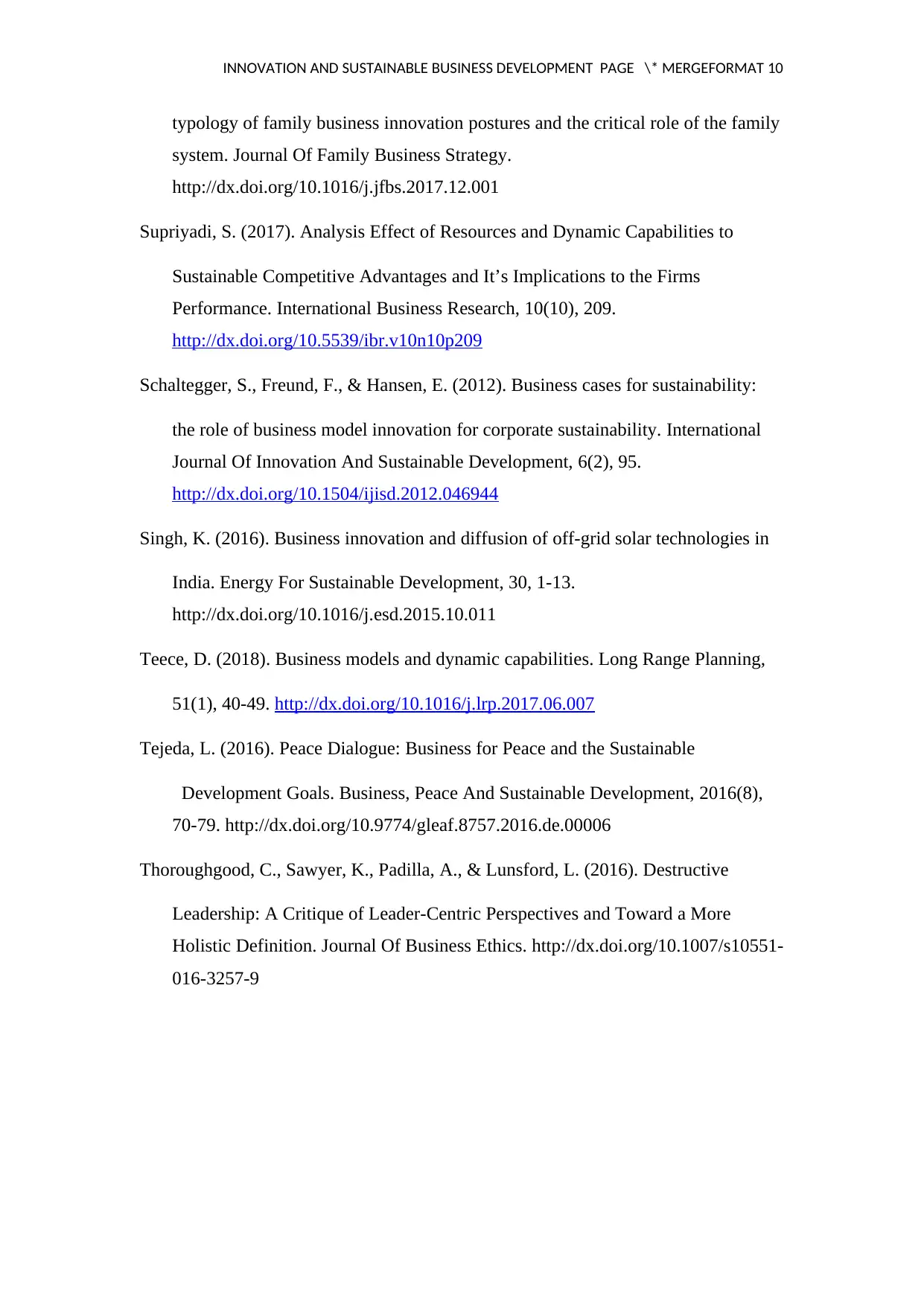
INNOVATION AND SUSTAINABLE BUSINESS DEVELOPMENT PAGE \* MERGEFORMAT 10
typology of family business innovation postures and the critical role of the family
system. Journal Of Family Business Strategy.
http://dx.doi.org/10.1016/j.jfbs.2017.12.001
Supriyadi, S. (2017). Analysis Effect of Resources and Dynamic Capabilities to
Sustainable Competitive Advantages and It’s Implications to the Firms
Performance. International Business Research, 10(10), 209.
http://dx.doi.org/10.5539/ibr.v10n10p209
Schaltegger, S., Freund, F., & Hansen, E. (2012). Business cases for sustainability:
the role of business model innovation for corporate sustainability. International
Journal Of Innovation And Sustainable Development, 6(2), 95.
http://dx.doi.org/10.1504/ijisd.2012.046944
Singh, K. (2016). Business innovation and diffusion of off-grid solar technologies in
India. Energy For Sustainable Development, 30, 1-13.
http://dx.doi.org/10.1016/j.esd.2015.10.011
Teece, D. (2018). Business models and dynamic capabilities. Long Range Planning,
51(1), 40-49. http://dx.doi.org/10.1016/j.lrp.2017.06.007
Tejeda, L. (2016). Peace Dialogue: Business for Peace and the Sustainable
Development Goals. Business, Peace And Sustainable Development, 2016(8),
70-79. http://dx.doi.org/10.9774/gleaf.8757.2016.de.00006
Thoroughgood, C., Sawyer, K., Padilla, A., & Lunsford, L. (2016). Destructive
Leadership: A Critique of Leader-Centric Perspectives and Toward a More
Holistic Definition. Journal Of Business Ethics. http://dx.doi.org/10.1007/s10551-
016-3257-9
typology of family business innovation postures and the critical role of the family
system. Journal Of Family Business Strategy.
http://dx.doi.org/10.1016/j.jfbs.2017.12.001
Supriyadi, S. (2017). Analysis Effect of Resources and Dynamic Capabilities to
Sustainable Competitive Advantages and It’s Implications to the Firms
Performance. International Business Research, 10(10), 209.
http://dx.doi.org/10.5539/ibr.v10n10p209
Schaltegger, S., Freund, F., & Hansen, E. (2012). Business cases for sustainability:
the role of business model innovation for corporate sustainability. International
Journal Of Innovation And Sustainable Development, 6(2), 95.
http://dx.doi.org/10.1504/ijisd.2012.046944
Singh, K. (2016). Business innovation and diffusion of off-grid solar technologies in
India. Energy For Sustainable Development, 30, 1-13.
http://dx.doi.org/10.1016/j.esd.2015.10.011
Teece, D. (2018). Business models and dynamic capabilities. Long Range Planning,
51(1), 40-49. http://dx.doi.org/10.1016/j.lrp.2017.06.007
Tejeda, L. (2016). Peace Dialogue: Business for Peace and the Sustainable
Development Goals. Business, Peace And Sustainable Development, 2016(8),
70-79. http://dx.doi.org/10.9774/gleaf.8757.2016.de.00006
Thoroughgood, C., Sawyer, K., Padilla, A., & Lunsford, L. (2016). Destructive
Leadership: A Critique of Leader-Centric Perspectives and Toward a More
Holistic Definition. Journal Of Business Ethics. http://dx.doi.org/10.1007/s10551-
016-3257-9
1 out of 10
Related Documents
Your All-in-One AI-Powered Toolkit for Academic Success.
+13062052269
info@desklib.com
Available 24*7 on WhatsApp / Email
![[object Object]](/_next/static/media/star-bottom.7253800d.svg)
Unlock your academic potential
Copyright © 2020–2025 A2Z Services. All Rights Reserved. Developed and managed by ZUCOL.



